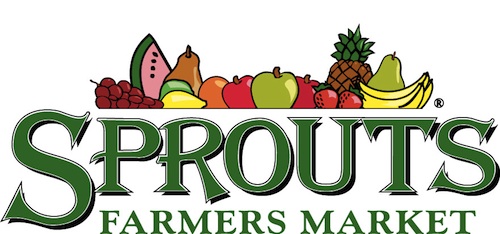Via Quartz, consider this. This is typically how a supermarket is laid out in the United States:
But this layout below belongs to Sprouts Farmers Market supermarkets, which are currently mostly in the Southwest:
See the difference? Typically when you enter a store, produce is to the right, and if you walk through and loop the exterior that way, you’ll hit fish, pork, poultry, meat, yogurt, eggs, OJ, dairy, cheese and frozen. That’s how my current primary supermarket works, and, come to think of it — that’s how pretty much every supermarket I’ve ever regularly attended has worked (minus one, in Queens, but Queens is a whole different ballgame for supermarkets). The typical one I just described is illustration No. 1. In illustration No. 2, the Sprouts one, notice that produce is essentially a destination — you need to want to get there, because it’s in the center back, give or take.
Most supermarkets keep produce on the “right wing” because they can make more money there. Lest you think I know nothing, here’s an actual expert:
“The outside of the store, the produce, the meat, and seafood, it has much higher margins,” says Euromonitor International analyst David McGoldrick.
The reason Sprouts can do it differently is a little bit about their primary locations — they’re in the Southwest and get a ton of produce from California on the cheap — and a little bit about their differing business model:
The reason is price. Sprouts’ business is based around aggressively-advertised low prices for produce—20% to 30% below conventional competitors. Those low prices mean high sales volume, which means, faster turnover, which means less waste, which means lower costs, which means the company makes money despite the lower prices.
As a result, Credit Suisse is calling Sprouts “one of the most compelling growth stories in all of retail.” Indeed, they actually have 366 percent growth since 2008. Wal-Mart has 112 percent in that period, and Whole Foods has 75 percent.
There are no doubt concerns about Sprouts’ ability to go bigger — if it tries to get into the American Southeast, for example, it will have proximity to Florida produce but it might have to raise prices a decent amount in that context. And then, of course, there are the California drought issues.
Those expansion concerns notwithstanding, investors look at 366 percent growth and start salivating. “Disruption” is all the rage these days too — lines might be next! — and turning a 60-year-old model straight on its head in terms of how to lay out a supermarket is interesting stuff too. There are no doubt challenges, but Sprouts is a brand area to keep an eye on.
Final sidebar: I went to a wedding in Columbus, OH last fall and one of my wife’s friends works in the supermarket industry (actually, out west/southwest too). On Sunday after the wedding, we hit up a couple of supermarkets in Columbus and basically analyzed the hell out of their layouts — apparently we’re all nerds — which was way more interesting than you might think. Where you put layouts of salty chips vs. red wine vs. cucumbers is all, theoretically, a science. I’m not sure every lil’ ol’ consumer views it that way, but someone is paid to view it that way, and it’s cool to walk around a generic supermarket with someone who actually knows something (I don’t). Other thing I learned on that trip is that middle-aged men in Columbus seem uncomfortable buying meat/poultry without calling their wives.


